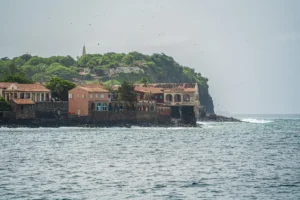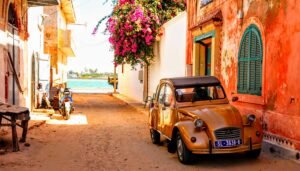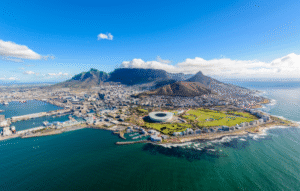


When you travel Senegal, the first thing you notice is how the country lives in layers: history beside modernity, silence beside rhythm, ocean beside desert. The moment I stepped off the bus in Dakar, the Atlantic sun was dropping toward the horizon. The city buzzed with taxis, fishermen pulling nets, and the sizzle of street food on corners. Yet beneath that energy, there was a deep quiet — the quiet of memory and place.
For two weeks, I moved across Senegal — to islands heavy with history, wetlands alive with wings, lakes that gleam pink under the sky, colonial towns that hold both decay and pride. Senegal isn’t simply a destination; it’s a lesson in how land, memory, and culture intertwine.
Below are the best places to travel Senegal, and the stories they tell.
1. Island of Gorée (Île de Gorée) – Memory on the Atlantic
Only a short ferry ride from Dakar, Gorée Island is small in size but vast in meaning. Its pastel-colored houses, narrow streets, and peeling shutters hide a darker truth.
What you see when you travel Senegal to Gorée:
-
The Maison des Esclaves (“House of Slaves”) with its cramped rooms and the infamous door of no return.
-
Colonial architecture built by Portuguese, Dutch, English, and French across centuries.
-
Ocean views stretching back toward Dakar’s skyline.
Why it matters:
-
Gorée was a key site in the Atlantic slave trade between the 15th and 19th centuries.
-
It is now a UNESCO World Heritage site, a place of memory and education.
-
Researchers explore heritage preservation, colonial architecture, and the debates on Gorée’s exact role in the slave trade.
👉 When you travel Senegal, Gorée teaches you that landscapes can hold both silence and witness.
2. Djoudj National Bird Sanctuary – Migration and Light
Heading north to the Senegal River delta, the land becomes watery and open. At Djoudj, the sky fills with wings, and you suddenly understand why Senegal is essential to global migration routes.
What to expect when you travel Senegal to Djoudj:
-
Wetlands covering 16,000 hectares of lakes, streams, and backwaters.
-
Over 1.5 million migratory birds: white pelicans, flamingos, spoonbills, cormorants.
-
Wildlife beyond birds — crocodiles, aquatic mammals, and seasonal changes in the delta.
Why it matters:
-
Ornithology: Djoudj is one of the first resting stops after the Sahara for countless species.
-
Ecology: Scientists study wetland health, invasive plants, and the impact of upstream dams.
-
Conservation: Balancing tourism with preservation is a challenge for local communities.
👉 To travel Senegal without seeing Djoudj is to miss its global role in bird migration.
3. Lake Retba (Lac Rose) – A Pink Mirror of Salt
Just northeast of Dakar, Lake Retba seems almost unreal when the sun hits it right. Its waters glow pink, and boats heavy with salt float near harvesters wading waist-deep.
What to see when you travel Senegal to Lac Rose:
-
Algae (Dunaliella salina) that give the lake its pink color, strongest in the dry season.
-
Salt harvesters at work, piling white mounds of salt.
-
Shifting colors — sometimes vivid pink, sometimes soft or grey depending on season and weather.
Why it matters:
-
Microbiology: A living laboratory for extremophile algae.
-
Environmental studies: The effects of climate change, tourism, and salt extraction.
-
Geography & tourism: A site that combines local livelihoods with global fascination.
👉 When you travel Senegal, Lac Rose shows how science, economy, and beauty can merge in a single lake.
4. Saint-Louis – Colonial Echoes and River Life
Farther north lies Saint-Louis, once the colonial capital of French West Africa. It is both elegant and weathered, where balconies lean toward the river and music drifts through narrow streets.
What to experience when you travel Senegal to Saint-Louis:
-
Colonial mansions and the iconic Faidherbe Bridge.
-
The Langue de Barbarie peninsula, with its sandy strip between river and ocean.
-
Fishing pirogues, bustling markets, and sunset over the river.
Why it matters:
-
Urban history: A living archive of colonial town planning.
-
Geography: Ongoing erosion of the peninsula and fragile coastal ecosystems.
-
Culture: Saint-Louis is alive with festivals, arts, and the famous Jazz Festival.
👉 Saint-Louis proves that to travel Senegal is also to step into layers of architecture, art, and geography.
5. Dakar’s Medina and Markets – City of Contrast
Back in Dakar, the city pulses with modern rhythms, street art, and the energy of markets. Here, tradition and modernity overlap.
What to see when you travel Senegal to Dakar:
-
The Médina: a maze of narrow streets, shops, and daily life.
-
Soumbédioune market: fish, crafts, noise, and movement by the sea.
-
Beaches: Les Almadies and Ngor, alive with surfers, seafood grills, and ocean winds.
Why it matters:
-
Sociology: Dakar shows how African cities grow while holding onto tradition.
-
Economics: Informal markets sustain local families and economies.
-
Geography: Coastal erosion and climate change threaten parts of Dakar’s shore.
👉 To travel Senegal without walking its Medina is to miss its heartbeat.
Practical Tips for Travel Senegal
When to go:
-
Dry season (Nov–Feb) = best for exploring wetlands, lakes, and travel comfort.
-
Rainy season (Jun–Oct) = green landscapes but tougher roads and flooding.
Getting around:
-
Roads connect most major destinations from Dakar.
-
Ferries run to Gorée; boats are essential in wetlands.
-
Local guides enhance visits to bird sanctuaries and historical sites.
Cultural respect:
-
Senegal is largely Muslim; dress modestly, especially outside cities.
-
Be sensitive at memorial sites like Gorée.
-
Always ask permission before photographing people.
Environmental awareness:
-
Wetlands are fragile and threatened by pollution.
-
Coastal erosion reshapes beaches and peninsulas.
-
Heritage sites require constant preservation efforts.
Research Opportunities in Senegal
When you travel Senegal, the country doesn’t just offer beauty — it offers research questions:
-
Ornithology: bird migration patterns at Djoudj.
-
Microbiology: algae and salinity at Lac Rose.
-
History & heritage: colonial architecture in Saint-Louis and Gorée.
-
Cultural studies: music, storytelling, and post-colonial identity.
-
Environmental geography: climate adaptation, erosion, and delta dynamics.
Reflection: Why Travel Senegal Stays With You
One evening in Saint-Louis, as pelicans skimmed the river, I thought about how journeys are also studies — of place, of memory, of ecology. On Gorée, in the dim rooms of the Maison des Esclaves, I felt the weight of history. At Djoudj, I saw migrations that outlast maps. At Lac Rose, I witnessed how humans and nature collaborate.
To travel Senegal is not just to admire its beauty. It is to listen. The country speaks through memory, through its ecosystems, and through its people. It teaches that landscapes are both fragile and resilient, that stories endure even when paint fades, and that journeys are also lessons.


